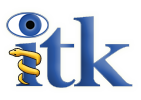ITK
 | |
| Original author(s) | Terry Yoo |
|---|---|
| Developer(s) | ITK development team |
| Initial release | October 24, 2002 (1.0.0)[1] |
| Stable release |
5.3.0 (December 20, 2022) [±] |
| Preview release | 5.4 RC4 (April 24, 2024) [±] |
| Written in | C++ |
| Operating system | Cross-platform |
| Type | Imaging informatics software |
| License(s) | Apache 2.0 |
| Website | ITK.org |
ITK (Insight Segmentation and Registration Toolkit) is a free open-source software toolkit for performing segmentation (the identification and classification of data found in a digitally sampled representation) and registration (the alignment of data between two disparate sources), typically in images acquired from one or more imaging modalities.[2] It should be noted this software is a toolkit meant to develop an imaging application and is not an imaging application itself.
Product history
In 1999, the National Institutes of Health's U.S. National Library of Medicine awarded a three-year contract to the Insight Software Consortium to develop an open-source registration and segmentation toolkit for imaging data. The consortium was made up of three commercial partners: GE Corporate R&D, Kitware, Inc., and MathSoft (now known as Insightful). It was also made up of three academic partners in the University of North Carolina, University of Tennessee, and University of Pennsylvania.[2] On January 24, 2000, the first commit was made to the project's new GitHub repository.[3] Several beta release were made to GitHub before the first stable release of the software arrived as version 1.0.0 on October 24, 2000.[1] After the contract was up, Kitware, Inc. continued as "an active participant, contributing not only technical developments but also building and strengthening the community."[4]
As of 2014[update], ITK is still being developed with the help of Kitware and funding from the National Library of Medicine at the National Institutes of Health.[5]
Features
- data representation and access using two principal classes
- numerous data processing pipelines
- IO framework
- support for spatial objects
- registration framework
- FEM framework
- level set framework
- wrapping
- numerous utilities
Consult the software guide for more information.
Hardware/software requirements
- CMake
- a C++ compiler
For more about installing, consult chapter two of the software guide.
Videos, screenshots, and other media
Entities using ITK
Further reading
External links
- ITK Git repository
- ITK at GitHub
- ITK at Freecode (deprecated)
- ITK at Kitware
References
- ↑ 1.0 1.1 "Releases - InsightSoftwareConsortium/ITK". GitHub. https://github.com/InsightSoftwareConsortium/ITK/releases?after=v3.16.0. Retrieved 10 June 2014.
- ↑ 2.0 2.1 "ITK - About". Kitware, Inc. http://www.itk.org/ITK/project/about.html. Retrieved 10 June 2010.
- ↑ "ENH: added README". GitHub. 24 January 2000. https://github.com/InsightSoftwareConsortium/ITK/commit/9eff002d378222d1c111afdf0eb5bae5f2f0aaeb. Retrieved 10 June 2014.
- ↑ "The Insight Toolkit". Kitware, Inc. http://www.kitware.com/opensource/itk.html. Retrieved 10 June 2014.
- ↑ "ITK - Participants". Kitware, Inc. http://www.itk.org/ITK/project/parti.html. Retrieved 10 June 2010.









